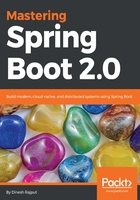
What this book covers
Chapter 1, Getting Started with Spring Boot 2.0, will give you an overview of Spring Boot 2.0 and all its new features, including some essential key components. You'll also get an overview of the greater the Spring Boot.
Chapter 2, Customizing Auto-Configuration in Spring Boot Application, will give an overview of the Spring Boot auto-configuration feature and explains how you can override the default autoconfiguration.
Chapter 3, Getting Started with Spring CLI and Actuator, will show you several ways to create Spring Boot applications using Spring Boot's web-based interface, the STS IDE, and Spring Boot CLI. In this chapter, we will discuss Spring Boot CLI deeply and will also see how to install it on your machine and how to use it to create Spring Boot applications. Also, you'll see Spring Boot's production-ready features using the Actuator.
Chapter 4, Getting Started with Spring Cloud and Configuration, will explore how to create a configuration server to provide a set of configuration files from a Git repository to client applications. In this chapter, the reader will also learn about Spring Cloud configuration service and how to build and consume the configuration service.
Chapter 5, Spring Cloud Netflix and Service Discovery, will explore Spring Cloud Netflix and Service Discovery with Eureka.
Chapter 6, Building Spring Boot RESTful Microservice, will build a RESTful atomic microservice that performs CRUD operations on an in-memory database, either HSQL or H2, using Spring Cloud and Spring Data, enable the service for service discovery registration to the Eureka server.
Chapter 7, Creating API Gateway with Netflix Zuul Proxy, will explore the need of the API gateway pattern for microservices communication, either from UI components or from inter service calls. We will implement an API gateway using the Netflix API Zuul. We will see how to set up a Zuul proxy in your application.
Chapter 8, Simplify HTTP API with Feign Client, will explore what Feign is and how it works. It gives a detailed explanation of how Feign can be extended/customized for business needs, with a reference implementation for a custom encoder, decoder, Hystrix, and exception handling with unit testing.
Chapter 9, Building Event-Driven and Asynchronous Reactive Systems, will provide a detailed overview of how to use event-driven architectures to build event-driven microservices as cloud-native applications. We will look at some of the important concepts and themes behind handling data consistency in distributed systems.
Chapter 10, Building Resilient Systems Using Hystrix and Turbine, will explore the circuit breaker pattern with a reference implementation using the Netflix Hystrix library, touching base on configuring the Turbine dashboard to aggregate hystrix streams from multiple services.
Chapter 11, Testing Spring Boot Application, will explore unit testing Spring Boot Services using JUnit and Mockito. All our reference implementation will have unit testing done, so this chapter is more of an aggregation of the different testing mechanisms available for microservices.
Chapter 12, Containerizing Microservice, will provide an introduction to containers, dockerizing the services built in the previous chapter, writing a Dockerfile, orchestrating the containers using docker-compose, and providing an orchestration example in Kubernetes.
Chapter 13, API Management, will explore the need for an API manager in distributed systems, setting up KONG open source API manager, configuring the API endpoints built in the previous chapters in the KONG API Manager, introducing Swagger for API standards, and finally closing with demonstrating rate limiting and logging using KONG.
Chapter 14, Deploying in Cloud (AWS), will explore deploying microservices in AWS EC2 instances manually and using cloudformation scripts. You will learn how to run a Docker-enabled Spring Boot microservice application on Amazon EC2 instances.
Chapter 15, Production Ready Service Monitoring and Best Practices, will elaborate on some of the best practices in building distributed systems and also will elaborate on performance monitoring for production ready services. We will introduce log aggregation using the ELK(Elasticsearch/Logstash/Kibana) stack for a distributed application.